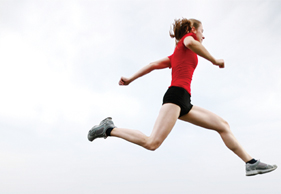If you are looking to improve your muscles’ ability to produce fast, powerful movements, plyometrics is the type of exercise you should be focusing on. Whilst generally used in explosive sports such as rugby and soccer, plyometrics improves the functions of the nervous system and is therefore beneficial to runners of all distances and disciplines. Keryn Foster, biokineticist and experienced runner, explains how you can incorporate plyometrics into your training.
PLYO-WHAT?
A plyometric movement involves the muscles being loaded then contracted, quickly and repeatedly. It makes use of the strength, elasticity and nerve supply of the muscle and surrounding tissues (tendons and fascia) to jump higher, run faster, throw farther, or hit harder, depending on how you use the exercise training. Plyometrics is used to increase the speed or force of muscular contractions, providing explosiveness and injury resistance.
The benefits of plyometrics include:
Improved muscle strength.
Continued strength for the finish of a race. It gives you that final kick down the finish straight.
Strength and stamina for effortless trail running.
Toughens tissues and trains nerve cells, which allows you to generate the strongest contraction possible in the shortest amount of time. This results in improved running economy, for example, you will use oxygen more efficiently while running.
Added to these are the benefits of improved balance, stride length and range of motion.
Muscles have a myostatic reflex; this means they contract automatically when the stretch receptors are stimulated. The knee jerk reflex is a perfect example of this. This means that the muscle must lengthen during the loading phase (eccentric muscle action) to be followed by an explosive shortening. All of this must happen in a fast, rhythmic manner.
BEWARE OF INJURY
While performing plyometric exercises, you are at a higher risk of injury because of the explosive nature of the movements. Before adding plyometric training to your weekly regime, you should have good levels of physical strength, muscle flexibility (because of the stretch phase preceding the contraction phase) and proprioception, which is the awareness of your body in space. It is an important component of the balance, coordination and agility which is a requirement when starting plyometrics.
This type of training is not ideal for those who are new to sport and running and athletes should not attempt it while injured.
HOW TO…
Plyometric training is high-intensity work and should not be done when you are very tired or stiff. It should be done a maximum of twice a week. You should never do speed work, hill work and plyometric training in one week and never on consecutive days.
So how do you include plyometrics in training? There should be a rest or light running day on either side of your plyometrics day, and you should take a two week break from all plyometric training every eight weeks. Your training week may look as follows:
Monday Recovery run
Tuesday Rest
Wednesday Plyometrics
Thursday Easy run
Friday Tempo
Saturday Rest
Sunday Long run
To warm up for the session, jog for at least five minutes followed by another five minutes of light skipping, jumping jacks and high knee prancing. It is best to perform these drills on grass as it will provide some cushioning. Try to find a soft, even surface for your workout. A sports field is ideal provided it is in good condition. Launch into each drill with your feet hip width apart and knees slightly bent. Never hold your breath!
HERE ARE FOUR PLYOMETRIC EXERCISES THAT WILL BENEFIT RUNNERS:
Alternate bounding
This is a very long running stride with exaggerated knee lifts. Bound about ten strides (counting on one leg only) then jog back slowly and repeat. Do four repetitions. As you adapt to the drill, increase to 15 strides and then to 20 strides.
Skipping
This is an exaggerated skipping motion. Drive your leading knee high, until the thigh is parallel to the ground while popping off the ground with the other leg, toes pointed. Count about ten skips (count on one leg only). Jog back slowly and repeat. Do four repetitions. As you progress, increase to 15 skips and then to 20.
Split squat jump
Start in a lunge position, and jump up and forward, pushing off the front leg. Land in the lunge position but with the opposite leg forward. This is an intense drill and requires maximal force with each repetition, so attempt no more than six during your first plyometric session. You can increase this to ten repetitions and then 16 repetitions.
Triple jumps
Standing evenly on both legs, swing your arms back, then forward as you leap. Jump as far as possible, landing on your right foot. Immediately jump forward again landing on your left leg, then hop and land on both feet. Aim for maximal distance the whole way! Take about a one minute break before repeating the drill. Do four repetitions. Build up to a maximum of ten repetitions.
KEEP THE FOLLOWING IN MIND
After the drills do an easy run, or reduced volume speed session. Remember to have an adequate cool down.
Athletes who weigh more than 110kg should be very careful and engage in only low intensity plyometric exercises.
Technique is of the utmost importance and if you are unsure about a movement, rather get someone to teach it to you before attempting it. All exercises can be done at 60% effort before doing the maximal effort repeats.
You should be well rested and uninjured before attempting these drills.
Modern Athlete Expert
KERYN FOSTER
Keryn is a biokineticist in private practice at the Sports Injuries Centre on the University of Cape Town’s Upper Campus. She has completed seven Two Oceans, four Comrades, three Puffers and one Ironman.


